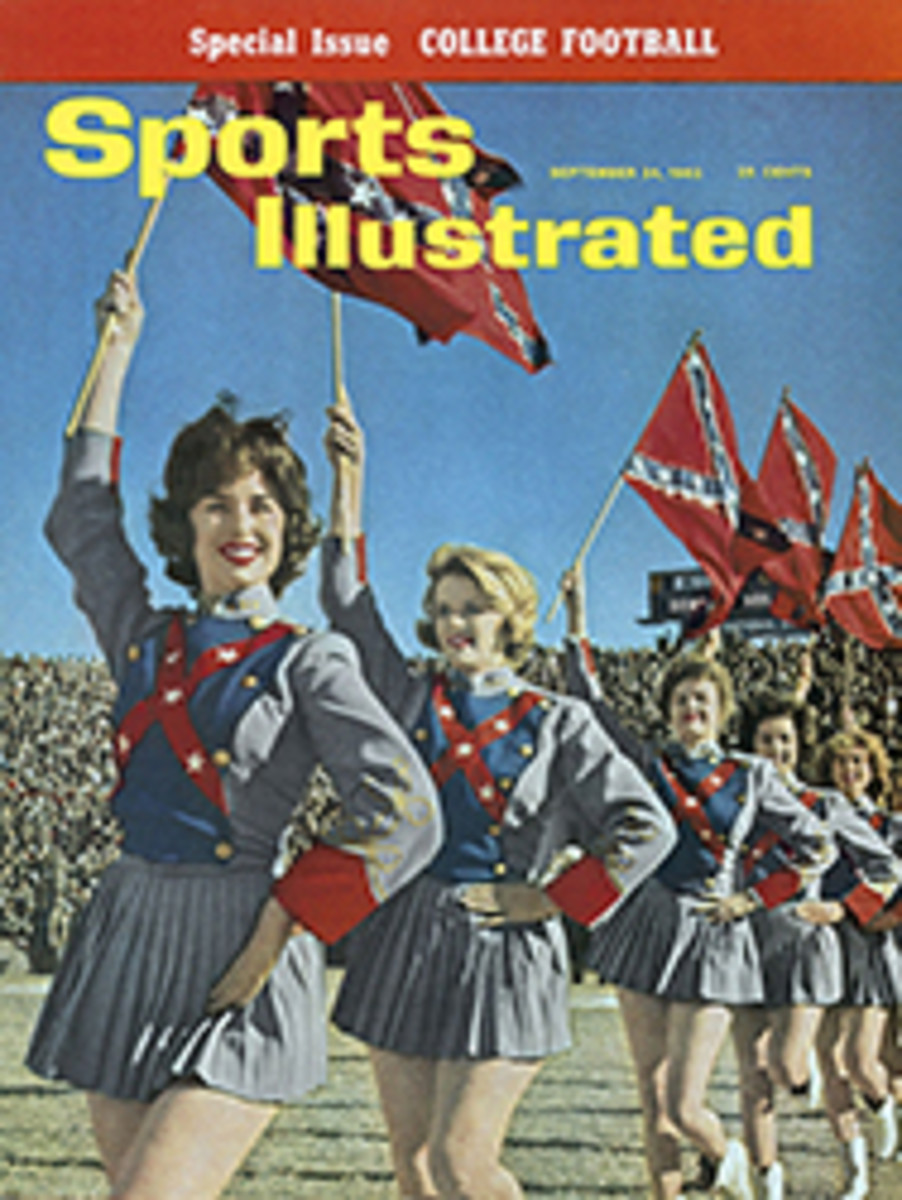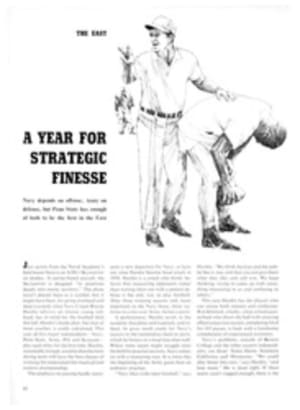
'WEATHERLY' UPSTAGES THE 18TH CHALLENGER
After an intermission of four years, the curtain last Saturday afternoon raised on a drama that first opened more than a century ago. On a vast watery stage off Newport the latest actors met—two tall 12-meter yachts, one, named Weatherly, the 18th defender of the America's Cup, and her adversary, Gretel, a challenger from the faraway land of Australia.
Shortly before 10 o'clock that morning, the principals gracefully made their entrance from the guarded docks of the Newport Shipyard riding at the end of long halters while a vast and varied spectator fleet fell in behind. The procession passed the rocky ledges of Castle Hill, moved out into the open ocean, and finally converged on the orange and white cup buoy nine miles offshore. So dense was the assemblage, in fact, that the scheduled noon curtain-raising was delayed an hour while the Coast Guard struggled to clear a lane for the race to be sailed along. Patrol craft would turn back one section like dogs herding a flock, but another flank would break through. However, there was one gatecrasher the patrol craft left respectfully alone—the destroyer Joseph P. Kennedy Jr., carrying the President of the United States and the First Lady, who had come to Newport for the races and a round of parties. Meanwhile feathery patterns of cirrus cloud formed in the western sky, and the light westerly morning breeze not only held but freshened to some 10 knots. Coupled with bright sunshine and excellent visibility, the stage was perfectly set by nature for this first engagement in a series that would not finally be decided until one yacht had won four races.
In an aura of mounting excitement, the starting area was finally cleared and signals hoisted for a windward-leeward race twice around, four six-mile legs adding up to the agreed cup distance of 24. The real drama began five minutes before the start, when—with both boats minus jibs—Jock Sturrock of Gretel took the initiative, sailing boldly up to put the challenger's bow on Weatherly's stern. The defender responded with the classic riposte, turning away in a tight circle, which Sturrock followed. While the seconds ticked away the two boats alternately jibed and tacked, each in pursuit of the other, as though circling an invisible maypole. With about a minute to go, Gretel broke out her jib, and forged past on Weatherly's windward side as both went for the line.
Bus Mosbacher's sense of timing at the helm of Weatherly was, as always, perfect under pressure. Although Sturrock apparently had put Gretel in a favored position, he was early, and vulnerable to being forced across the line. Out came Weatherly's genoa, and Bus held high. Sturrock had no choice but to tack and bear away. At this moment the gun fired. Weatherly crossed carrying full way, while Gretel skinned past the buoy on the starboard tack, slowed after maneuvering.
Although the start was a tactical victory for Bus, it showed that Jock Sturrock was unawed and unafraid, willing to engage in preliminary rough and tumble, perhaps to be a formidable competitor later on. When Weatherly made her covering tack, she was two boat-lengths or more ahead. The wind had increased slightly, and there was a nasty jumble of sea, partly the result of myriad wakes as the spectator fleet formed lines to follow. From the onset Gretel looked like a good boat, driving through and footing well. Following closely aboard Weatherly's tender, it seemed to me that Gretel was not pointing quite as high as Weatherly, due perhaps to a perceptible sag in her headstay. But aided by a gradually backing wind, within a few minutes she had wiped out much of Weatherly's opening advantage. At this point the Aussies were doing very well indeed. After a hitch of approximately two miles, Gretel tacked towards Weatherly, which held starboard tack right of way. When Mosbacher came about on Gretel's lee bow, it was assumed by many observers that the challenger was ahead. However, after the race Bus told me that he could have crossed, but instead chose the safe leeward position.
The choice soon paid off. As Weatherly squeezed up, Gretel was backwinded. Twenty-six minutes after the start, the challenger made her second tack—and tacked herself and the drama out of the race. For the wind had backed so far to the southward that both boats were laying the mark, a fact which was not immediately realized aboard Gretel. For long, agonizing seconds the Australian sailed away on the wrong tack. When Gretel finally tacked, she had to reach back into Weatherly's wake. There was now a long span of blue water between the rivals, adding up to one minute 35 seconds at the mark.
After this, Gretel never again drew close to the flying American sloop. At the turn, the challenger's spinnaker was set far quicker, perhaps accounting for her 23-second gain on the leg, and again at the leeward mark the Australian crew work was superior—Weatherly rounded without a jib. Yet on the second windward leg, wind now piping above 20 knots, the defender gained an additional 2 minutes, and added another 28 seconds on the final run home for a victory margin of 3 minutes 45 seconds.
Once again it was proven that the men on deck are as important to victory as the machines they create. The work and thought which had gone into the perfection of Gretel was canceled on this day through a miscalculation of the importance of navigation. In order to strengthen the challenger's cockpit group, regular navigator Terry Hammond surrendered his place aboard because it was assumed that in clear weather stake boats would be easy to find. Yet, as a running plot was not being kept of the bearing of the mark, no one realized the effect of the wind-shift, so every foot sailed after the fatal tack was wasted distance. "I had to tack to clear my wind," Jock Sturrock told me afterwards, "but I wouldn't have gone so far if I had known we were overstanding." Aboard Weatherly, Navigator Dick Matthews provided Bus Mosbacher with the split-second information that kept Weatherly from covering.
What might have happened had Gretel been close enough to capitalize on Weatherly's sail-handling lapses at the marks? This is a big question, one that subsequent races may answer. I had hoped to see two races before making a preliminary judgment, but Australia's request for a postponement on Monday made that impossible. On the basis of the first act, it seems that although Gretel is a good boat, Weatherly is a better one, moving well against the challenger on all points of sailing in winds ranging from 10 to above 20 knots. In fact, the defender's relative superiority was greatest driving to windward on the second round in the strongest gusts and roughest seas of the day. Her ability in these conditions bodes ill for Aussie hopes. During the postponement. Designer Alan Payne was expected to experiment with the rake of Gretel's newly restepped mast, looking for the key to unlock the cabinet in which America keeps the cup. At this writing the key seems safely in Bus Mosbacher's pocket.
PHOTO
RICHARD MEEK
PLUNGING THROUGH WAVES AND SPRAY, THE AUSSIE 12-METER (LEFT) PURSUES THE FAST-MOVING AMERICAN DEFENDER
PHOTO
FIRST LADY MUSES ON 12-METER MODELS AS PRESIDENT LEAVES CUP BANQUET
PHOTO
TINY PRO-AUSTRALIAN MOVES IN BOLDLY ON DESTROYER CARRYING PRESIDENT

